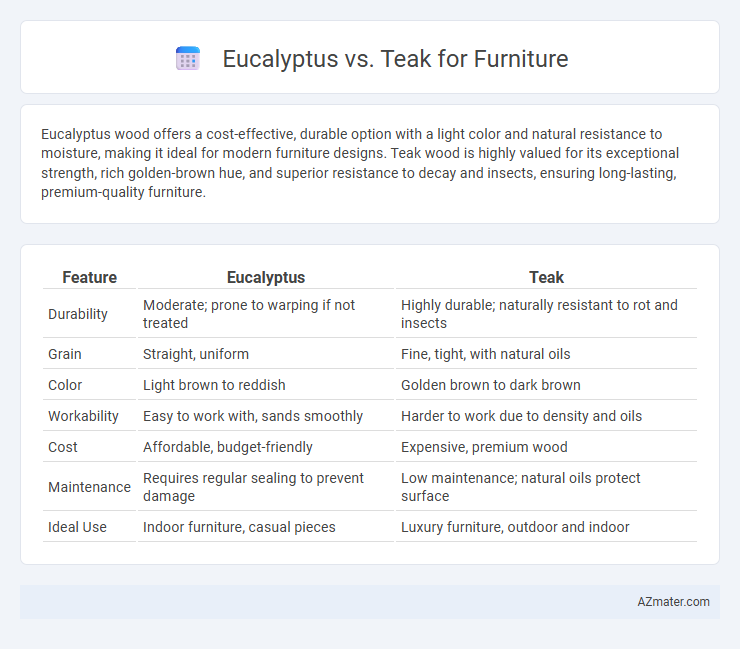Eucalyptus wood offers a cost-effective, durable option with a light color and natural resistance to moisture, making it ideal for modern furniture designs. Teak wood is highly valued for its exceptional strength, rich golden-brown hue, and superior resistance to decay and insects, ensuring long-lasting, premium-quality furniture.
Table of Comparison
| Feature | Eucalyptus | Teak |
|---|---|---|
| Durability | Moderate; prone to warping if not treated | Highly durable; naturally resistant to rot and insects |
| Grain | Straight, uniform | Fine, tight, with natural oils |
| Color | Light brown to reddish | Golden brown to dark brown |
| Workability | Easy to work with, sands smoothly | Harder to work due to density and oils |
| Cost | Affordable, budget-friendly | Expensive, premium wood |
| Maintenance | Requires regular sealing to prevent damage | Low maintenance; natural oils protect surface |
| Ideal Use | Indoor furniture, casual pieces | Luxury furniture, outdoor and indoor |
Introduction to Eucalyptus and Teak Wood
Eucalyptus wood is valued for its durability, moisture resistance, and eco-friendly fast growth, making it ideal for sustainable furniture production. Teak wood, renowned for its natural oils, exceptional strength, and resistance to decay and pests, remains a premium choice for high-end, long-lasting furniture. Both woods offer distinctive grain patterns and color variations, influencing their aesthetic and functional applications in indoor and outdoor furniture.
Origin and Botanical Differences
Eucalyptus furniture wood originates primarily from Australia and belongs to the Myrtaceae family, characterized by fast-growth and a combination of hardwood properties with resistance to moisture. Teak wood, sourced from Southeast Asia, notably Myanmar and India, is part of the Lamiaceae family, renowned for its dense grain, natural oils, and extreme durability. Botanical differences between Eucalyptus and Teak include Eucalyptus having a fibrous, pale yellow to reddish-brown hue, whereas Teak features a tight grain structure with golden-brown heartwood that darkens over time.
Durability and Longevity Comparison
Eucalyptus wood offers moderate durability, with natural resistance to decay and insects, making it suitable for indoor and occasional outdoor furniture with proper treatment. Teak excels in durability and longevity due to its dense grain and high natural oil content, providing superior resistance to weather, pests, and rot, ideal for outdoor and heavy-use furniture. Over time, teak furniture ages gracefully without significant deterioration, while eucalyptus requires more maintenance to retain strength and appearance.
Resistance to Weather and Insects
Eucalyptus wood offers moderate resistance to weather and insect damage, benefiting from its dense grain that naturally repels moisture and pests, but it requires proper sealing for outdoor furniture longevity. Teak wood is highly resistant to weather and insects due to its natural oils that protect against water, decay, and termite attacks, making it an ideal choice for outdoor and garden furniture. Both woods provide durability, but teak's superior natural protection reduces maintenance needs compared to eucalyptus.
Appearance: Color, Grain, and Texture
Eucalyptus furniture typically features a pale to medium brown color with subtle reddish hues, showcasing a straight grain and a smooth to slightly coarse texture that offers a contemporary, clean look. Teak stands out with its rich golden to medium brown tone that darkens over time, complemented by a distinctive straight or wavy grain pattern and a dense, oily texture that exudes warmth and luxury. The color stability and unique grain variations of teak make it highly sought-after for elegant, durable furniture pieces, while eucalyptus provides a lighter, more affordable alternative with a sleek aesthetic.
Maintenance and Care Requirements
Eucalyptus furniture requires regular oiling and protection from excessive moisture to prevent warping and cracking, making maintenance moderately demanding compared to teak. Teak is naturally rich in oils, offering superior resistance to water, pests, and decay, which significantly reduces the need for frequent sealing or treatment. While both woods benefit from periodic cleaning, teak's durability and low-maintenance qualities make it an ideal choice for outdoor furniture exposure.
Sustainability and Environmental Impact
Eucalyptus furniture offers faster growth rates and higher carbon sequestration compared to teak, supporting more sustainable forestry practices. Teak's slower growth and high demand often result in deforestation concerns and habitat disruption, while eucalyptus plantations can be managed with lower environmental impact. Both woods require responsible sourcing, but eucalyptus presents a more renewable option due to its rapid renewability and efficient land use.
Cost and Availability Analysis
Eucalyptus furniture offers a cost-effective alternative to teak, as eucalyptus wood is generally more affordable due to its faster growth rate and widespread availability. Teak, prized for its durability and natural resistance to decay, commands higher prices and is less abundant because of slower growth and stricter harvesting regulations. While eucalyptus provides budget-friendly options with adequate strength for indoor and outdoor use, teak remains the premium choice for long-term investment in high-end furniture due to its exceptional longevity and natural oils.
Best Applications for Each Wood Type
Eucalyptus wood, known for its durability and resistance to moisture, is ideal for outdoor furniture such as patio sets and garden benches, where weather resistance is crucial. Teak wood, prized for its natural oils and rich grain, excels in luxury indoor furniture like dining tables and cabinets that require both aesthetic appeal and long-lasting strength. Both woods are sustainable choices, but teak's higher price reflects its superior resistance to decay, making it suitable for high-end applications.
Conclusion: Which Wood is Right for Your Furniture?
Eucalyptus offers a cost-effective, durable option with natural resistance to moisture and pests, making it ideal for budget-conscious, outdoor furniture. Teak provides exceptional longevity, rich grain, and superior weather resistance, often preferred for high-end, heirloom pieces. Choosing between eucalyptus and teak depends on your budget, desired aesthetic, and the furniture's intended use environment.

Infographic: Eucalyptus vs Teak for Furniture
 azmater.com
azmater.com